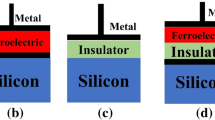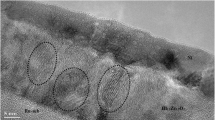Abstract
In this paper, unique ferroelectric-like characteristics in amorphous (a-) ZrO2-based devices enabled by mobile ions are systematically investigated at room temperature and cryogenic. The physical origin of the ferroelectric-like behaviors of the metal/a-ZrO2/metal capacitor is confirmed to be the migration of ions exhibiting strong frequency dependency due to the limited velocity of the mobile ions, which is proven by the comparison between experimental results and theoretical analysis. The ferroelectric-type hysteresis will be reduced sharply with the decrease of the temperature, which is essentially different from the reported doped-HfO2 FeFET. This further confirms that the origin of the ferroelectric-like characteristics is the migration and redistribution of the mobile ions.
Similar content being viewed by others
References
Ryu S, Han J, Moon D, et al. One-transistor nonvolatile SRAM (ONSRAM) on silicon nanowire SONOS. In: Proceedings of IEEE International Electron Devices Meeting (IEDM), 2009. 1–4
Park K H, Park C M, Kong S H, et al. Novel double-gate 1T-DRAM cell using nonvolatile memory functionality for highperformance and highly scalable embedded DRAMs. IEEE Trans Electron Devices, 2010, 57: 614–619
Li X, Ma K, George S, et al. Design of nonvolatile SRAM with ferroelectric FETs for energy-efficient backup and restore. IEEE Trans Electron Devices, 2017, 64: 3037–3040
Zhou J, Han G, Li Q, et al. Ferroelectric HfZrOx Ge and GeSn PMOSFETs with Sub-60 mV/decade subthreshold swing, negligible hysteresis, and improved Ids. In: Proceedings of IEEE International Electron Devices Meeting (IEDM), 2016. 1–4
Yin G, Cai Y, Wu J, et al. Enabling lower-power charge-domain nonvolatile in-memory computing with ferroelectric FETs. IEEE Trans Circuits Syst II, 2021, 68: 2262–2266
Thirumala S, Jain S, Raghunathan A, et al. Non-volatile memory utilizing reconfigurable ferroelectric transistors to enable differential read and energy efficient in-memory computation. In: Proceedings of IEEE/ACM International Symposium on Low Power Electronics and Design, 2019. 1–6
Jerry M, Chen P, Zhang J, et al. Ferroelectric FET analog synapse for acceleration of deep neural network training. In: Proceedings of IEEE International Electron Devices Meeting (IEDM), 2017. 1–4
Müller J, Böscke T S, Bräuhaus D, et al. Ferroelectric Zr0.5Hf0.5O2 thin films for nonvolatile memory applications. Appl Phys Lett, 2011, 99: 112901
Müller J, Böscke S T, Müller S, et al. Ferroelectric hafnium oxide: a CMOS-compatible and highly scalable approach to future ferroelectric memories. In: Proceedings of IEEE International Electron Devices Meeting (IEDM), 2013. 1–4
Zheng Y, Zhong C, Zheng Y, et al. In-situ atomic visualization of structural transformation in Hf0.5Zr0.5O2 ferroelectric thin film: from nonpolar tetragonal phase to polar orthorhombic phase. In: Proceedings of Symposium on VLSI Technology (VLSIT), 2021. 1–2
Starschich S, Menzel S, Böttger U. Evidence for oxygen vacancies movement during wake-up in ferroelectric hafnium oxide. Appl Phys Lett, 2016, 108: 32903
Liu H, Li J, Wang G, et al. Analog synapses based on nonvolatile FETs with amorphous ZrO2 dielectric for spiking neural network applications. IEEE Trans Electron Devices, 2022, 69: 1028–1033
Peng Y, Xiao W, Han G, et al. Memory behavior of an A12O3 gate dielectric non-volatile field-effect transistor. IEEE Electron Device Lett, 2020, 41: 1340–1343
Peng Y, Xiao W, Liu F, et al. Non-volatile field-effect transistors enabled by oxygen vacancy-related dipoles for memory and synapse applications. IEEE Trans Electron Devices, 2020, 67: 3632–3636
Liu H, Peng Y, Han G, et al. ZrO2 ferroelectric field-effect transistors enabled by the switchable oxygen vacancy dipoles. Nanoscale Res Lett, 2020, 15: 120
Li Y, Fuller E J, Asapu S, et al. Low-voltage, CMOS-free synaptic memory based on LiXTiO2 redox transistors. ACS Appl Mater Interfaces, 2019, 11: 38982–38992
Feng Z, Peng Y, Shen Y, et al. Ferroelectric-like behavior in TaN/High-k/Si system based on amorphous oxide. Adv Electron Mater, 2021, 7: 2100414
Wu C, Ye H, Shaju N, et al. Hf0.5Zr0.5O2-based ferroelectric gate HEMTs with large threshold voltage tuning range. IEEE Electron Device Lett, 2020, 41: 337–340
Chen J, Liu H, Jin C, et al. A physics-based model for mobile-ionic field-effect transistors with steep subthreshold swing. IEEE J Electron Devices Soc, 2022, 10: 706–711
Mo F, Tagawa Y, Saraya T, et al. Scalability study on fcrroclcctric-HfO2 tunnel junction memory based on non-equilibrium green function method with selfconsistent potential. In: Proceedings of IEEE International Electron Devices Meeting (IEDM), 2018. 1–4
Lyu X, Si M, Sun X, et al. Ferroelectric and anti-ferroelectric hafnium zirconium oxide: scaling limit, switching speed and record high polarization density. In: Proceedings of Symposium on VLSI Technology, 2019. 44–45
Endo K, Kato K, Takenaka M, et al. Electrical characteristic of atomic layer deposition La2O3/Si MOSFETs with ferroelectric-type hysteresis. Jpn J Appl Phys, 2019, 58: SBBA05
Kumar A, Pillai P B, Song X, et al. Negative capacitance beyond ferroelectric switches. ACS Appl Mater Interfaces, 2018, 10: 19812–19819
Wang Z, Ying H, Chern W, et al. Cryogenic characterization of a ferroelectric field-effect-transistor. Appl Phys Lett, 2020, 116: 042902
Mittmann T, Materano M, Chang S, et al. Impact of oxygen vacancy content in ferroelectric HZO films on the device performance. In: Proceedings of IEEE International Electron Devices Meeting (IEDM), 2020. 1–4
Acknowledgements
This work was supported by National Key Research and Development Project (Grant No. 2022ZD0119002), National Natural Science Foundation of China (Grant Nos. 62204226, 62025402, 62090033, 91964202, 62204229, 62204228), Major Scientific Research Project of Zhejiang Lab (Grant No. 2021MD0AC01), and Zhejiang Province Key R&D Programs (Grant Nos. 2022C01232, 2021C05004).
Author information
Authors and Affiliations
Corresponding authors
Rights and permissions
About this article
Cite this article
Liu, H., Chen, J., Jin, C. et al. Ferroelectric-like behaviors of metal-insulator-metal with amorphous dielectrics. Sci. China Inf. Sci. 66, 200410 (2023). https://doi.org/10.1007/s11432-023-3759-x
Received:
Revised:
Accepted:
Published:
DOI: https://doi.org/10.1007/s11432-023-3759-x




